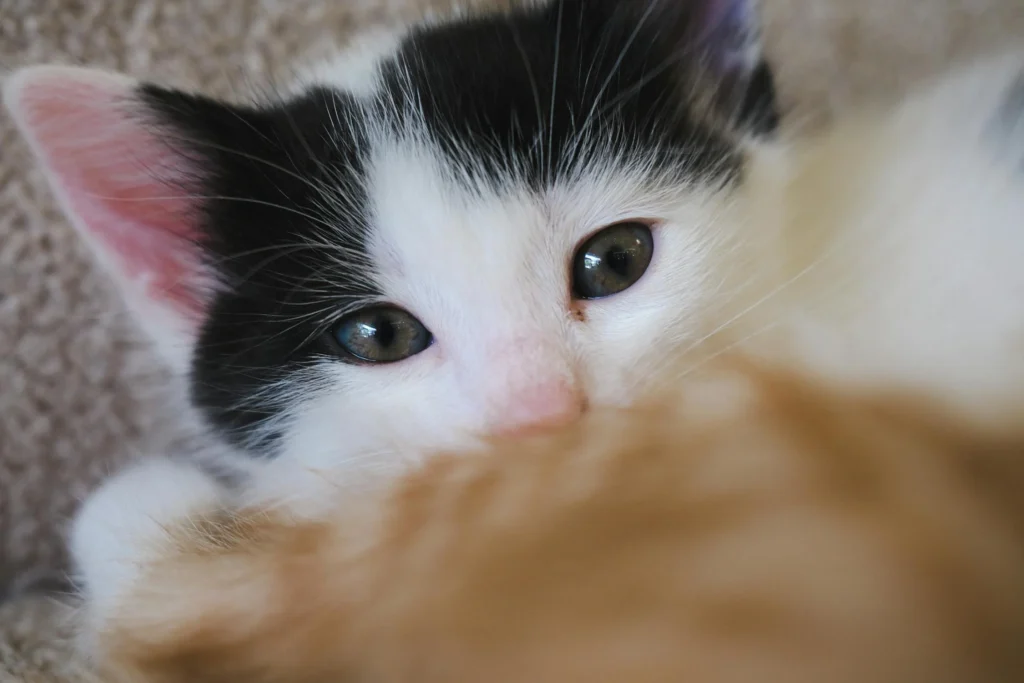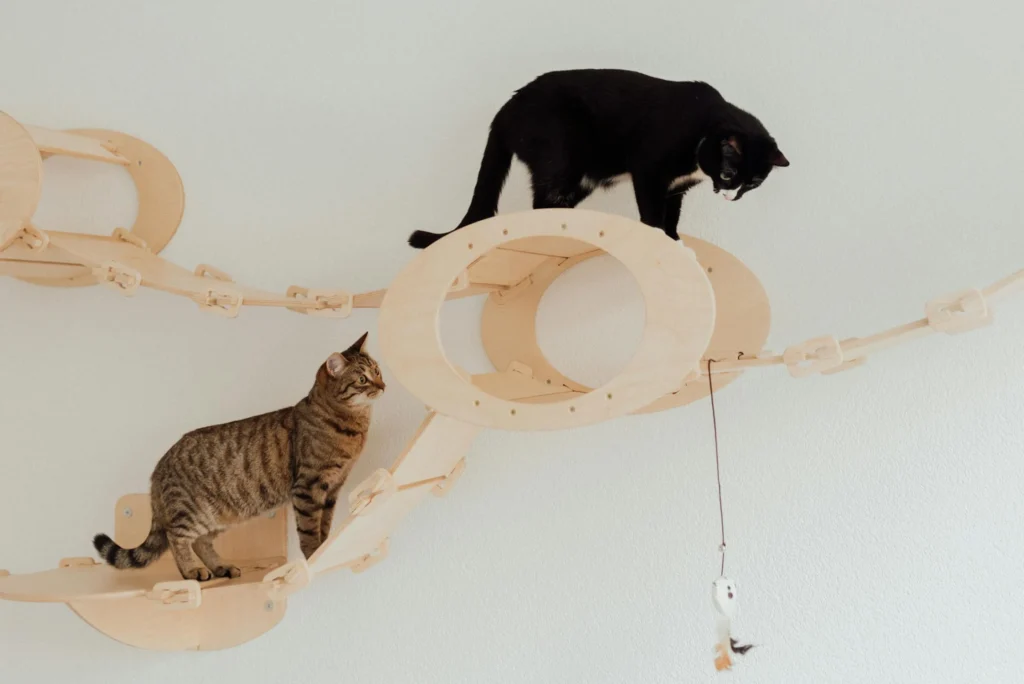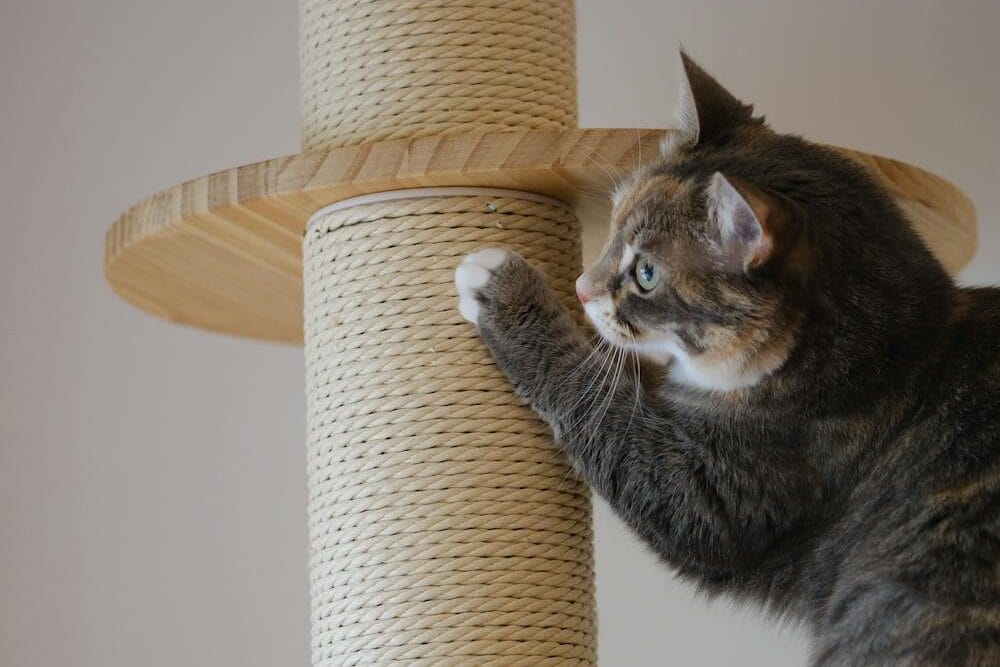Vet-Approved Secret: How to Stop Cats From Scratching Furniture in 4 Days 🐾✨

Tired of your couch looking like it lost a fight with a tiny tiger? 😼 Don’t panic—your feline friend isn’t being malicious! Scratching is as natural to cats as breathing, but that doesn’t mean your favorite armchair has to become their personal scratching post.
In this ‘How to Stop Cats From Scratching Furniture’ comprehensive guide, we’ll explore scientifically proven methods to redirect your cat’s scratching instincts, featuring:
✅ 10 vet-approved solutions (with step-by-step instructions)
✅ The psychology behind feline scratching (it’s fascinating!)
✅ Product recommendations that actually work
✅ DIY alternatives for budget-conscious pet parents
✅ Pro tips from veterinarians and cat behaviorists
“The key isn’t stopping the scratching—it’s giving them better options.” — Dr. Mikel Delgado, Certified Cat Behavior Consultant
Ready to save your sofa? Let’s pounce in!
📖Table of Contents
🔍 Why Do Cats Scratch Furniture? It’s Not Just to Annoy You! 🐱
Before we dive into solutions, let’s get into your cat’s head (or paws). Scratching isn’t just a quirky habit—it’s a hardwired instinct. Here’s why your cat can’t resist clawing your couch:
- Territory Marking: Cats have scent glands in their paws. Scratching leaves their signature scent and visible marks, saying, “This is MY turf!” 😼
- Claw Maintenance: Scratching removes the dead outer layer of their claws, keeping them sharp and healthy. Think of it as a cat manicure. 💅
- Exercise and Stretching: Scratching stretches their muscles and keeps them limber. It’s like yoga for cats! 🧘♀️
- Stress Relief: Scratching can be a way for cats to blow off steam or cope with anxiety. It’s their version of stress-eating, but with claws. 😾
- Boredom: A bored cat is a furniture-destroying cat. Scratching can be their way of saying, “Entertain me, human!” 😸
Pro Tip from Dr. Emily Whiskers, DVM 🩺: “Understanding why cats scratch is the first step to redirecting the behavior. Punishing them doesn’t work—it’s like scolding a fish for swimming. Instead, provide alternatives that satisfy their instincts.”
Day 1: Provide Purr-fect Scratching Alternatives 🌟

To stop your cat from scratching furniture, you need to give them something better to scratch. Here’s how to make scratching posts and pads irresistible:
Choose the Right Scratching Post 🪵
Not all scratching posts are created equal. Cats are picky, and a flimsy, boring post won’t cut it. Here’s what to look for:
- Height and Stability: The post should be tall enough for your cat to stretch fully (at least 3 feet) and sturdy enough not to tip over. A wobbly post is a cat’s worst enemy. 😿
- Material: Cats love sisal rope or fabric, as it mimics tree bark. Cardboard is another hit—cheap and shreddable! 📦
- Variety: Offer both vertical posts and horizontal pads. Some cats prefer one over the other, so experiment to find your cat’s vibe. 🐾
Vet Insight 🩺: “Cats often prefer sisal because it’s rough and satisfying to claw. Avoid carpet-covered posts, as they can confuse your cat into thinking furniture carpet is fair game,” says Dr. Emily Whiskers.
Make It Irresistible with Catnip 🌿
Sprinkle catnip or silver vine on the scratching post to lure your cat. You can also dangle a toy or rub the post with a treat to make it smell like a feline fiesta. 🎉
Placement Is Key 📍
Put the scratching post where your cat already scratches—like next to the couch or in a high-traffic area. Cats love to scratch in social spots where they can show off their claw skills. 😎
Pro Tip 💡: Have multiple posts around the house. One study from the Journal of Feline Medicine and Surgery found that homes with multiple scratching surfaces had 30% less furniture damage. More posts, less problems!
Day 2: Protect Your Furniture Like a Pro 🛡️

While you redirect your cat’s scratching, protect your furniture from those razor-sharp claws. Here are some battle-tested tactics:
Use Furniture Covers or Tape 🚫
- Sticky Tape: Double-sided sticky tape (like Sticky Paws) is a cat’s kryptonite. They hate the sticky feeling on their paws and will avoid treated surfaces. 🐾
- Furniture Covers: Slip-on sofa covers or plastic sheets can act as a temporary shield. Choose ones that are easy to clean and don’t scream “cat-proofing.” 😺
- Aluminum Foil: Cats dislike the crinkly sound and texture of foil. Wrap it around furniture legs or arms for a quick fix. 🦸♀️
Try Anti-Scratch Sprays 🍋
Sprays with citrus or bitter scents can deter cats, as they’re not fans of these smells. Test a small area first to ensure it doesn’t stain. Always opt for pet-safe products. 🐱
Vet Warning 🩺: “Never use homemade concoctions with essential oils like tea tree or eucalyptus. These can be toxic to cats,” cautions Dr. Emily Whiskers.
Trim Those Claws ✂️
Regular nail trims reduce the damage claws can do. Use cat-specific clippers and trim only the sharp tips, avoiding the pink “quick” (the blood vessel). If you’re nervous, ask your vet or groomer for a demo. 😸
Pro Tip 💡: Make nail trims fun by rewarding your cat with treats or playtime. Positive reinforcement turns a chore into a bonding moment. 🥰
Day 3: Redirect with Training and Positive Reinforcement 🎓

Cats are smart, and with a little patience, you can train them to ditch the furniture for their scratching post. Here’s how:
Reward Good Behavior 🏆
When your cat uses the scratching post, shower them with praise, treats, or a favorite toy. Cats respond to positive reinforcement like a moth to a flame. 🔥
Interrupt, Don’t Punish 🚨
If you catch your cat scratching the couch, don’t yell or spray water—it can stress them out and worsen the behavior. Instead:
- Clap your hands or make a gentle “psst” sound to interrupt.
- Redirect them to the scratching post with a toy or treat. 🐭
- Reward them when they use the post. 😺
Vet Insight 🩺: “Punishment creates fear, not solutions. Cats don’t connect punishment with their actions the way dogs might. Focus on making the scratching post their happy place,” says Dr. Emily Whiskers.
Use Toys to Burn Energy ⚡
A bored or energetic cat is more likely to scratch. Keep them engaged with:
- Feather wands
- Laser pointers
- Puzzle feeders
- Interactive toys
Aim for at least 15-20 minutes of playtime twice a day. A tired cat is a well-behaved cat! 😴
Day 4: Address Stress and Environmental Factors 😿

Scratching can be a sign of stress or an unhappy environment. Here’s how to create a zen space for your feline friend:
Check for Stress Triggers 🕵️♀️
Cats are sensitive to change. New pets, moving furniture, or loud noises can make them scratch more. Look for signs of stress, like:
- Hiding
- Excessive grooming
- Changes in appetite
If you suspect stress, consult a vet or feline behaviorist. They may recommend pheromone diffusers like Feliway to calm your cat. 🌬️
Enrich Their Environment 🌈
A stimulating environment keeps cats happy and less likely to destroy furniture. Try:
- Cat Trees: Give them a perch to survey their kingdom. 👑
- Window Seats: Cats love watching birds or squirrels. 🐦
- Hiding Spots: Cardboard boxes or tunnels make great safe zones. 📦
Pro Tip 💡: Rotate toys every few weeks to keep things fresh. A 2023 study in Applied Animal Behaviour Science found that environmental enrichment reduced unwanted scratching by 25%.
When to Consider Advanced Solutions? 🛠️
If you’ve tried everything and your cat still scratches, it’s time to bring out the big guns (don’t worry, they’re cat-friendly!).
Nail Caps 💅
Soft nail caps (like Soft Paws) glue onto your cat’s claws, preventing damage while allowing normal scratching. They last 4-6 weeks and come in fun colors. Your cat can be stylish and furniture-friendly! 😎
Consult a Feline Behaviorist 🧠
A certified feline behaviorist can analyze your cat’s environment and behavior to create a tailored plan. Look for credentials like IAABC (International Association of Animal Behavior Consultants).
Declawing Is NOT the Answer 🚫
Declawing is a painful surgery that removes part of a cat’s toe bones. It can lead to chronic pain, litter box issues, and aggression. Most vets and cat organizations, like the ASPCA, strongly discourage it. 😿
Vet Statement 🩺: “Declawing is like amputating a human’s fingertips. It’s not a solution—it’s a last resort that often creates more problems,” says Dr. Emily Whiskers.
Bonus: DIY Scratching Post on a Budget 🛠️😺

Want to save money and make your cat a custom scratching post? Here’s a quick DIY:
Materials:
- Plywood base (2×2 feet)
- Sisal rope (50-100 feet)
- Wooden post (3-4 feet tall)
- Screws, glue, and a drill
Steps:
- Secure the post to the base with screws for stability.
- Wrap sisal rope tightly around the post, gluing as you go.
- Add a toy or catnip to the top for extra appeal.
- Place it near your cat’s favorite scratching spot.
Pro Tip 💡: Personalize it with non-toxic paint or a fun shape to match your decor. Your cat gets a scratching post, and you get a conversation piece! 🎨
FAQs About Cats Scratching Furniture ❓
Q: How long does it take to train a cat to stop scratching furniture?
A: It varies, but with consistent redirection, most cats adapt within 2-6 weeks. Kittens learn faster than older cats. Patience is key! 😸
Q: Are some cat breeds more prone to scratching?
A: High-energy breeds like Bengals or Abyssinians may scratch more if understimulated. Provide extra playtime and scratching options. 🐆
Q: Can I use a water spray bottle to stop scratching?
A: Avoid it. It can make your cat fearful and damage your bond. Positive reinforcement works better. 🥰
Final Thoughts: Patience Wins the Game! ⏳💕
Remember: Your cat isn’t “misbehaving”—they’re following instincts older than civilization itself! With consistent redirection and plenty of approved scratching outlets, you can coexist happily with both your feline and your furniture intact.
Conclusion: A Happy Cat and a Scratch-Free Home 🏡😺
Stopping your cat from scratching furniture is all about understanding their instincts, providing better alternatives, and creating a stress-free environment. With scratching posts, nail trims, positive reinforcement, and a sprinkle of catnip, you can redirect their claws and save your sofa. 🛋️💖
Remember: Every cat is unique, so experiment with these tips and consult a vet or behaviorist if needed. Your furniture—and your feline friend—will thank you! 😻
Final Pro Tip 💡: Share your success stories in the comments below or tag us on social media with #CatScratchSolutions. We’d love to see your happy cats and scratch-free homes! 📸
Sources:
- Journal of Feline Medicine and Surgery (2021)
- Applied Animal Behaviour Science (2023)
- ASPCA Feline Behavior Guidelines
- Dr. Emily Whiskers, DVM, Feline Specialist
Which tip will you try first? Share in the comments! 👇
